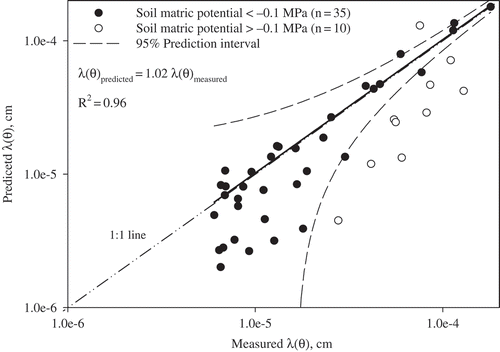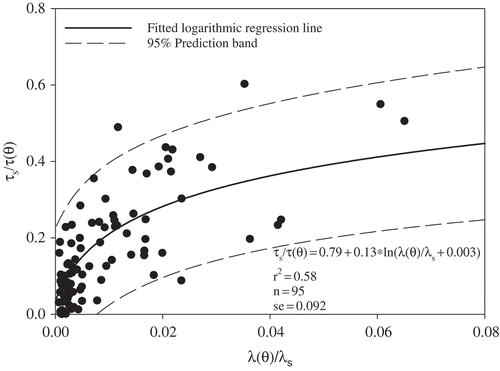Abstract
A simple and empirical scaling approach is proposed for predicting the unsaturated hydraulic conductivity (Kus) based on the microscopic characteristic length (λ). The approach was tested on 19 different soils. The results showed that the proposed approach was useful for a wide range of soil water content, except at relatively high soil moisture. The predicted λ(θ) values were overestimated by 2%, which led to 5% overestimation in prediction of Kus(θ) at soil matric potentials of less than –0.1 MPa. However, the predictions of Kus(θ) were not satisfactory at soil matric potentials of greater than –0.1 MPa. The results also revealed that the proposed approach was accurate for predicting Kus(θ) in the dry range of soil water content. Future models should be developed based on the empirical and physical scaling approaches to improve prediction of soil hydraulic properties at high water contents. This means that new scaling factors need to incorporate more information about the pore geometry.
Editor D. Koutsoyiannis; Associate editor A. Carsteanu
Résumé
Nous proposons une approche de mise à l’échelle simple et empirique pour prévoir la conductivité hydraulique non saturée (Kus) à partir de la longueur caractéristique microscopique (λ). L’approche a été testée sur 19 sols différents. Les résultats ont montré que l’approche proposée était utile pour une large gamme de teneurs en eau du sol, sauf pour les humidité du sol relativement fortes. Les valeurs de λ(θ) prévues étaient surestimées de 2%, ce qui conduit à une surestimation de 5% pour la prévision de Kus(θ) pour des potentiels matriciels du sol de moins de ‒0,1 MPa. Toutefois, les prévisions de Kus(θ) n’ont pas été satisfaisantes pour des potentiels matriciels du sol supérieurs à ‒0,1 MPa. Les résultats ont également révélé que l’approche proposée est précise pour prévoir Kus(θ) dans la gamme des teneurs en eau des sols secs. Cependant, des futurs modèles devraient être élaborés en se basant sur des approches de mise à l’échelle empiriques et physiques afin d’améliorer la prévision des propriétés hydrauliques du sol pour de fortes teneurs en eau. Cela signifie que de nouveaux facteurs d’échelle devraient inclure plus d’informations sur la géométrie des pores.
1 INTRODUCTION
In soil hydrology, the saturated hydraulic conductivity (Ks) and unsaturated hydraulic conductivity (Kus) are the essential and crucial parameters for practical and modelling purposes. Efficient soil and water management necessitates the knowledge of soil hydraulic behaviour at small and large scales, especially the soil water content–pressure head relationship, θ(h), and the soil hydraulic conductivity–soil water content relationship, K(θ) (Basile et al. Citation2006).
While θ(h) is simply measured in the laboratory, direct measurement of K(θ) is difficult, time-consuming and expensive. Many laboratory and field experiments have been done to directly and indirectly measure Kus, with laboratory measurements being more straightforward and accurate than those in the field (Eching et al. Citation1994, Zhuang et al. Citation2001). However, the major challenge faced in estimating Kus in recent decades has been how to deal with soil heterogeneity (van Genuchten and Sudicky Citation1999). Both field and laboratory studies have shown that Kus is spatially variable, such that it is difficult to use a single value to represent a specific site (Bertuzzi and Bruckler Citation1996, Zhuang et al. Citation2001, Basile et al. Citation2006).
Scaling methods based on the similar media concept (SMC; Miller and Miller Citation1956) present a simple and powerful tool to approximately describe the field spatial variability of soil hydraulic properties (Ahuja et al. Citation1984). Examples of the application of scaling on some soil hydraulic properties have covered, but are not limited to Kus (Warrick et al. Citation1977, Simmons et al. Citation1979, Bertuzzi and Bruckler Citation1996, Poulsen et al. Citation1998, Zhuang et al. Citation2001, Basile et al. Citation2006), Ks (Ahuja and Williams Citation1991, Miyazaki Citation1996, Zhuang et al. Citation2000, Nakano and Miyazaki Citation2005), infiltration (Youngs and Price Citation1981, Ahuja et al. Citation1984, Rasoulzadeh and Sepaskhah Citation2003, Machiwal et al. Citation2006), and soil water retention curves (Kosugi and Hopmans Citation1998). In general, scaling is a method that relates the soil properties of different soil types or spatial locations by simple conversion factors called scaling factors (Ahuja and Williams Citation1991). Scaling factors can be derived by a dimensional analysis (physically-based) technique that is based on the existing physical similarity in the system, or by a functional normalization (empirical-based) method (Tillotson and Nielsen Citation1984). In this study, the empirical-based method is followed.
Generally, the literature that reports the application of the similar media concept is restricted to soils that have reasonably similar morphology, while studies in the last decade have mainly focused on approaches for non-similar media concepts (Comegna et al. Citation2000, Rahimi et al. Citation2011, Ahmadi and Sepaskhah Citation2012). This restriction is more pronounced in terms of hydraulic conductivity, especially Kus. Tyler et al. (Citation1999) described the lack of accessible information on Kus and argued that the estimated values of Kus match fairly well with the observed values at high water contents; however, few data are available for comparison at very low water contents. Their argument clearly highlights the importance of development and validation of new theories that can be used to reliably estimate Kus over a wide range of soil moisture content.
So far, different scaled models have been presented to estimate Kus based on Ks. The Mualem (Citation1976) and van Genuchten (Citation1980) models are widely used because they are developed based on the soil water retention characteristics. However, several studies have recommended that soil hydraulic conductivity models should incorporate information about pore size distribution and geometry (Bird et al. Citation2000, Zhuang et al. Citation2000, Rahimi et al. Citation2011, Ahmadi and Sepaskhah Citation2012). Zhuang et al. (Citation2001) stated that “new theories or concepts that mechanically include component of pore/particle arrangements are urgently needed in the simulation of soil flow”.
The estimation methods that are often used provide Kus data that match relatively well with the observations at high water contents; however, the datasets that include Kus measurements at very low water contents are limited (Tyler et al. Citation1999). Therefore, the objective of this study is to test a simple scaling approach for prediction of Kus based on the microscopic characteristic length, λ, that would be applicable for a wide range of soil moisture contents, and especially low soil moisture contents.
2 MATERIALS AND METHODS
2.1 Study area and soil characteristics
In this study 19 natural soils were collected from different locations in Fars province, southern Iran. summarizes some of the physico-chemical characteristics of the soils. The soils were categorized into six soil textures: loam, loamy sand, sandy loam, silt loam, silty clay loam and silty clay; the sand, silt and clay contents were in the ranges 4–80%, 16–62% and 4–46%, respectively. The soil textures covered both coarse and fine textures, with relatively high amounts of silt particles in most soil samples. The soil texture classification was based on the particle size distribution of the United States Department of Agriculture (USDA), i.e. clay fraction: <2 μm, silt fraction: 2–50 μm and sand fraction: 50–2000 μm.
Table 1 Some physico-chemical and saturated soil characteristics of the soil texture/types used in the study.
Ten out of 19 soil types were selected for calibration and the remaining nine soil types were used for the validation (). The calibration and validation datasets were chosen such that the validation dataset included the soil textures/types that were not generally used in calibration. The calibration dataset was used to fit a scaled model according to the scaling factors, while the validation dataset was used to check the validity of the scaled model.
For each soil, Ks was measured in the laboratory on undisturbed soil samples using the falling head method (Klute and Dirksen Citation1986). The Kus of the undisturbed soil samples (height: 4 cm, diameter: 7 cm) was measured in the laboratory using the Gardner (Citation1956) method. To measure Kus, the undisturbed saturated soil sample was placed in the pressure plate apparatus and then different pressure heads were applied on the sample and the volume of the outflow water was recorded at different time intervals. Each sample was exposed to five pressure heads: 0.03, 0.1, 0.5, 1 and 1.5 MPa. For each applied pressure, the experiment continued until equilibrium was reached. The Gardner method assumes that Kus and the hydraulic impedance are constant during the pressure increments (Rijtema Citation1959, Jackson et al. Citation1963).
The Kus associated with each pressure head is determined by using (Gardner Citation1956):
where Kus is the unsaturated soil hydraulic conductivity (cm d-1); V is the volume of saturated soil (cm3); V0 is the total outflow from the soil sample at each pressure head (cm3); h is the applied pressure head (cm); β is the slope between the logarithmic difference of the total outflow and outflow at any time, i.e. log(V0 – V(t)) against time (d-1); ρ is the density of water (g cm3); g is the acceleration due to gravity (cm s-2), and L is the length of the soil sample (cm).
The volumetric soil moisture content at each pressure head was measured separately on the same soil sample. Dry bulk densities were determined by oven-drying the undisturbed soil samples at 105°C for 24 h. The particle size distribution (PSD) (not shown) of each soil was determined by hydrometer (particles <75 μm) and wet sieving (particles <75 μm) of the bulk soil sample, using the approaches described by Gee and Bauder (Citation1986) and Gee and Or (Citation2002).
2.2 Scaling theory and methodology
For scaling the Ks of a porous media, the microscopic characteristic length, λs, is defined as (Youngs Citation1990):
In this study, we propose and adopted the generalized form of equation (2) that implements Kus as:
The sole objective of scaling is to coalesce a set of functional relationships into a single function using the scaling factors that describe the set as a whole (Machiwal et al. Citation2006). Using the functional normalization (empirical-based scaling) approach that aims to reduce the scatter of experimental data and concentrate them on a mean reference curve (Tillotson and Nielsen Citation1984, Comegna et al. Citation2000), the following scaling factors (θ* and λ*) are proposed to scale the measured data (θ, λ(θ)) into a reference curve (scaled model):
In equations (2) and (3), η, ρ and g are constant. Therefore, Ks is scaled by the square of λ*, i.e. λ*2 = Kus(θ)/Ks, where λ reflects the pore geometry of the soil (Sposito and Jury Citation1990). This is indeed in agreement with the SMC of Miller and Miller (Citation1956) and its physically-based scaling concept. Warrick (Citation1990) and Sposito and Jury (Citation1990) have also reported that the characteristic length is a scaling factor for unsaturated hydraulic conductivity. The λ*2 relationship clearly shows that Kus is directly related to Ks by the square of the soil microscopic characteristic length, meaning that λ* is the square root of relative hydraulic conductivity.
Corey (Citation1977) introduced the following equation for the prediction of tortuosity at different values of θ:
Sposito and Jury (Citation1990) pointed out that λ reflects the geometric arrangement of both the pore space and the solid particles. Since measurement of τ at different soil moisture contents is not a routine and simple task in soil hydrology, we investigated whether there would be significant mathematical relationships between τ and λ to describe the tortuosity at different values of θ as follows:
3 RESULTS AND DISCUSSION
3.1 Calibration of the scaled model
The proposed scaling factors basically rely on the functional normalization techniques and empirical methods (Tillotson and Nielsen Citation1984) that aim to reduce the dispersion of experimental data to a reference scaled curve. shows the scatter plot of the calibration data, while shows that the scaling factors (equations (4) and (5)) could reasonably coalesce the very scattered datasets into an exponentially scaled model as follows:
Fig. 1 Scatter plot of the measured soil moisture content, θ, and the calculated microscopic characteristic length, λ, based on equation (2). Points represent the calibration data corresponding to θs, θ0.03, θ0.1, θ0.5, θ1 and θ1.5.
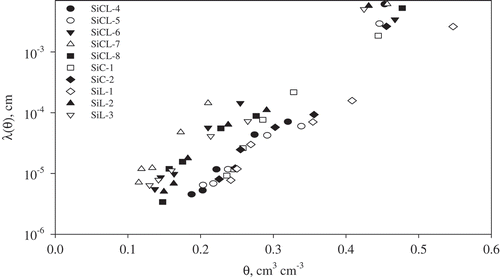
Fig. 2 Diagram of the calibration data scaled according to the scaling factors of equations (4) and (5). The regression line shows the best fitted scaled curve for the whole scaled calibration dataset.
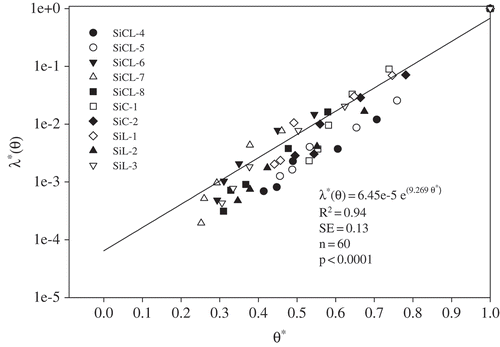
The SMC of Miller and Miller (Citation1956) was originally proposed for homogenous and similar geometry of porous media. Basically, the hydraulic conductivity and tensiometric data are scaled with degree of saturation rather than the soil water content in the SMC concept (Comegna et al. Citation2000), but equation (10) overcomes this rigorous concept by implementing the microscopic characteristic length of the porous medium as the pore geometry of the soil (Sposito and Jury Citation1990, Comegna et al. Citation2000). This is in agreement with Youngs (Citation1990), who suggested that the SMC might be extended to non-similar media concepts (NSMC). Youngs and Price (Citation1981) showed that it was possible to apply the SMC for one-dimensional infiltration on a range of soil materials composed of particles of different sizes and shapes. Nevertheless, Miyazaki (Citation1996) extended the NSMC for scaling soil hydraulic conductivity based on the soil bulk density. Subsequently, the NSMC was applied successfully on Kus (Zhuang et al. Citation2001) and Ks (Zhuang et al. Citation2000, Nakano and Miyazaki Citation2005, Rahimi et al. Citation2011, Ahmadi and Sepaskhah Citation2012).
Zhuang et al. (Citation2000) and Zhuang et al. (Citation2001) suggested that the advantage of the NSMC to the SMC models in scaling the Ks and Kus is due to incorporation of bulk density and some parameters of soil texture. Zhuang et al. (Citation2001) did not succeed in predicting Kus using the NSMC scaling approach for a wide range of soil textures in the UNSODA database (Nemes et al. Citation1999). Most likely the failure in prediction of Kus was due to the variety of Kus measuring methods reported in UNSODA. This highlights the limitation of applying publicly available datasets and databases (Ahmadi and Sepaskhah Citation2012). Zhuang et al. (Citation2001) suggested that to improve the performance of the scaling models, it is necessary to develop theories or concepts that include soil structural parameters (pore size, shape and orientation of solids) that could results in pedotransfer functions for scaling purposes. However, an advantage of the simple scaling approach is that the Kus is explicitly dependent on θ and λ(θ), with the latter, in turn, dependent on the geometry of porous materials (Sposito and Jury Citation1990, Youngs Citation1990).
An advantage of the proposed scaling approach is its simplicity. In many cases Ks and θs are available or could be easily measured. Thus, with this basic information, and for practical aspects, it is possible to predict Kus for any assumed θ(h) within the same range of soil textures. Sadeghi et al. (Citation2011) reported that the performance of scaling the soil hydraulic properties was sensitive to the soil textural range and initial soil water content conditions. They reported that, under such conditions, a classification of soil texture and initial conditions may alleviate the poor performance of scaling.
When this approach is coupled with the scaling approach for the water retention curve (Kosugi and Hopmans Citation1998, Sadeghi et al. Citation2011), it could make a solid base of scaling the soil hydraulic properties in different areas. However, in contrast to former studies indicating that hydraulic conductivity was related to the effective saturation, Θ (Mualem Citation1976, van Genuchten Citation1980, Comegna et al. Citation2000), we realized that the scaled hydraulic conductivities could be related to θs, as shown in equation (4), without any prior requirement for θγ as the residual soil moisture. In this regard, Mohammadi and Vanclooster (Citation2011) and Comegna et al. (Citation2000) proposed that, in scaling and modelling approaches, the microgeometry of the porous medium is a better soil physical representative than the effective saturation, since it includes the geometry of pore sizes and considers the presence of the water film in large and small pores. Lebeau and Konrad (Citation2010) and Ippisch et al. (Citation2006) have discussed the validity of the Mualem (Citation1976) and van Genuchten (Citation1980) models under various water flow patterns in the soil pores.
3.2 Validation of the scaled model
shows the results of validation of the scaled model (equation (10)) for predicting λ(θ). The scaled model predicted well the λ(θ) at soil moisture contents drier than field capacity (FC, or generally at soil matric potentials of less than –0.1 MPa), with overestimates of λ(θ) by approx. 2%. The RMSE of 7.93 × 10-6 cm is very small and shows the accuracy of the model prediction for soil matric potentials of less than –0.1 MPa.
Apparently, the scaled model cannot predict λ(θ) at relatively high soil moisture contents; here, the predicted λ(θ) values are seriously underestimated. The reason for this discrepancy is not clear but we speculate that, at high soil water contents, the scaled model cannot effectively take into consideration the relatively free movement of water in the soil pores and probably other soil structure parameters dominate this phenomenon. It is noteworthy that at high soil water content there exists a two-fluid phase system such that the water-filled pores are bounded by water–solid and water–air interfaces, which have different surface tension and thus may lead to different geometries of the water-filled pore spaces that influence the performance of models (Tuller and Or Citation2001, Lebeau and Konrad Citation2010, Mohammadi and Vanclooster Citation2011, Tokunaga Citation2011). However, this may reveal the mismatch between the calibration and validation data for high soil moisture contents.
To check if the scaled model is applicable for predicting λ(θ) at high water content on other datasets, the data reported by Basile et al. (Citation2006) for two sandy loam soils were used. The data of two sites (3 and 15 that basically held the primary specifications for this verification purpose) were chosen because the soil matric potential varied between –0.001 and –0.03 MPa, implying high moisture content limited to FC. The soil texture at both sites is sandy loam. shows the results of this analysis and it is clear that the data are scattered markedly below the 1:1 line and yet the scaled model underestimates λ(θ) for high soil moisture contents. Therefore, we suggest that the scaled model might be used for predicting λ(θ) at soil water contents lower than FC, preferably at soil matric potentials of less than –0.1 MPa.These results confirm the argument of Sadeghi et al. (Citation2011) and Lebeau and Konrad (Citation2010), who mentioned that the performance of scaling models strongly depends on the initial conditions, such as soil water content, pore size distribution and geometry, and the domain of soil textures. In such conditions, classification of the soil traits and then applying the scaling approach to each class may overcome the poor performance of the models (Sadeghi et al. Citation2011).
Fig. 4 Comparison of the measured and predicted λ(θ) with the 1:1 line at high soil moisture contents in our study (FC) and the literature (Basile et al. Citation2006).
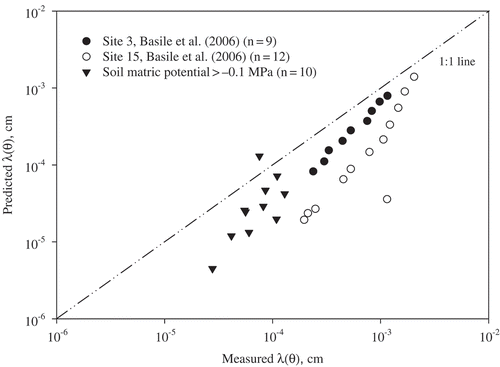
The results of validation of the scaled model on predicting Kus are shown in . The Kus is overestimated by around 5%. Similar to the results for λ(θ), the predicted Kus at high soil water contents (soil matric potential > –0.1 MPa) are considerably underestimated (open circles in ), but the predicted Kus at low soil water contents (soil matric potentials < –0.1 MPa) are more satisfactory, with an overestimation of about 5% (solid circles in ). The RMSE is 9.46 × 10-4 cm d-1, which is small and demonstrates the accuracy of the model prediction for soil matric potentials of less than –0.1 MPa. This reveals that the scaled model is more capable of predicting Kus in the dry range of soil water content. Therefore, this simple scaling approach is successful in predicting the Kus at water contents lower than FC. However, Zurmühl and Durner (Citation1998) showed the effect of bimodal pore size distributions on the behaviour of Kus at high soil water contents, which is different from the unimodal pore size distribution hypothesis of this study. So it seems that the disagreements between the measured and simulated Kus are partly affected by pore size distribution. It should be mentioned that bimodal pore size distribution affects the λ(θ) through the geometries of the water-filled pore spaces (Tuller and Or Citation2001), which lead to estimation of Kus.
Fig. 5 Validation of the new scaling approach (scaled model) on Kus(θ) using the validation data ().
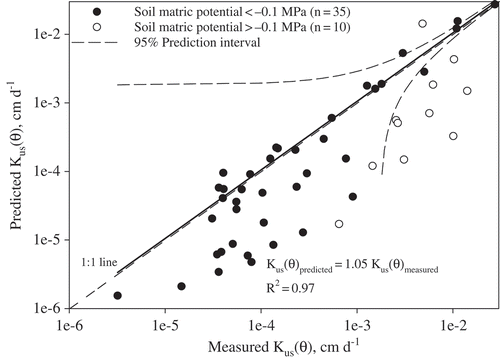
More studies are needed to improve the accuracy of the scaling factors by developing pedotransfer functions and incorporating other soil physical parameters that govern soil water movement at high water potentials in sandy to clayey soils (Sadeghi et al. Citation2011). Important factors, such as soil water potential and soil water content, could potentially serve as useful parameters for scaling soil hydraulic conductivity (Sadeghi and Ghahraman Citation2010, Sadeghi et al. Citation2011). They reported that for an improved scaling process for Ks, not only similarity in soil structure is necessary, but also the soil water retention characteristics should be similar. Accordingly, Zhuang et al. (Citation2001) reported that it is not possible to find a good match between observed and predicted Kus when applying different scaled hydraulic conductivity models on a wide range of soil type data in the UNSODA database (Nemes et al. Citation1999). Thus it remains a challenging issue in the prediction of Kus which should be addressed in future research to improve the accuracy of Kus models by incorporating more determining soil factors that affect Kus (Zhuang et al. Citation2000, Citation2001).
3.3 Relationship between tortuosity and microscopic characteristic length
Soil hydraulic conductivity depends on the soil pore geometry and tortuosity is an identification of this geometry, revealing the path of water movement in the soil. However, measurement of tortuosity is not easy and any indirect calculation of tortuosity in terms of the normalized τ given by equations (11) and (12) is useful in modelling soil hydraulic properties. Our analysis revealed that there is a significant relationship () between τ (calculated by equation (6)) and λ (calculated by equations (2) and (3)), as follows:
There are various laboratory and field methods for measuring Kus (a brief review of methods may be found in Eching et al. Citation1994, Hillel Citation1998, Tyler et al. Citation1999, Basile et al. Citation2006). Each of the available methods gives different Kus values for a specific soil sample, depending on the measurements set-up. Therefore, the reported Kus values in databases such as UNSODA and other publicly available datasets are subject to some degree of systematic variation, and hence no predictions can be unbiased. So, for modelling purposes the data should preferably originate from a specific method of measurement to minimize the influence of systematic variations in the data during the scaling process as much as possible. Mohammadi and Vanclooster (Citation2011) and Ahmadi and Sepaskhah (Citation2012) have extensively discussed the data concerns, their quality and their consistency in scaling methods. However, such scaled models might be validated on additional datasets to extend their applicability. As already reported by Tyler et al. (Citation1999), datasets similar to that used in this study are scarce and other popular international databases, such as UNSODA (Nemes et al. Citation1999), are not applicable and could lead to inconsistent results (Zhuang et al. Citation2001).
Measurement of Kus is costly and time-consuming, especially when it is required to know its values over a large area that has high spatial variation. The proposed scaling approach is very helpful and applicable in such areas where a primary and accurate knowledge of Kus is required for planning soil and water management scenarios (e.g. irrigation and drainage, groundwater recharge, soil water redistribution and infiltration).
4 CONCLUSIONS
This study introduced a simple scaling approach based on the scaled microscopic characteristic length (λ) to predict Kus in the dry range of soil water contents. The calibration results (10 soil types) showed that the introduced scaling factors were successful in coalescing the scattered observations of λ(θ) and θ into a reference equation for the scaled model. The validation results on the second dataset (nine soil types) showed that the scaled model could be successfully used to predict λ with 2% overestimation for different soil moistures, which resulted in prediction of Kus at the same soil moisture contents with around 5% overestimation. However, the scaled model was not accurate for predicting Kus at soil moisture contents around field capacity and slightly drier (soil matric potential > –0.1 MPa), representing the wet range of soil moisture. Further analysis revealed that including λ as an indication of soil structure within the formulation of soil hydraulic conductivity could be more informative than use of tortuosity, τ, because λ was more sensitive to soil moisture variations than τ.
Overall, this study has suggested a simple method that could be effectively used in predicting Kus in the dry range of soil water contents. Future research on developing soil hydraulic conductivity models should concentrate in detail on the specific soil physical parameters that affect Kus at relatively high soil moisture contents. Developing pedotransfer functions which include the fundamental soil structure and architecture parameters, such as pore geometry, would help in deriving more accurate scaling factors.
REFERENCES
- Ahmadi, S.H. and Sepaskhah, A.R., 2012. Prediction of saturated hydraulic conductivity of compacted soils using empirical scaling factors. Archives of Agronomy and Soil Science, 58, 1303–1316.
- Ahuja, L.R., Naney, J.W., and Nielsen, D.R., 1984. Scaling soil water properties and infiltration modeling. Soil Science Society of America Journal, 48, 970–973.
- Ahuja, L.R. and Williams, R.D., 1991. Scaling water characteristics and hydraulic conductivity based on Gregson-Hector-McGowan approach. Soil Science Society of America Journal, 55, 308–319.
- Basile, A., et al., 2006. Scaling approach to deduce field unsaturated hydraulic properties and behavior from laboratory measurements on small cores. Vadose Zone Journal, 5, 1005–1016.
- Bertuzzi, P. and Bruckler, L., 1996. A scaling based estimation of unsaturated hydraulic properties at a field scale. Irrigation Science, 17, 23–30.
- Bird, N.R.A., Perrier, E., and Rieu, M., 2000. The water retention function for a model of soil structure with pore and solid fractal distributions. European Journal of Soil Science, 51, 55–63.
- Comegna, V., Damiani, P., and Sommella, A., 2000. Scaling the saturated hydraulic conductivity of a vertic ustorthens soil under conventional and minimum tillage. Soil and Tillage Research, 54, 1–9.
- Corey, A.T., 1977. Mechanics of heterogeneous fluids in porous media. Fort Collins, CO: Water Resources Publications.
- Eching, S.O., Hopmans, J.W., and Wendroth, O., 1994. Unsaturated hydraulic conductivity from transient multistep outflow and soil water pressure data. Soil Science Society of America Journal, 58, 687–695.
- Gardner, W.R., 1956. Calculation of capillary conductivity from pressure plate outflow data. Soil Science Society of America Proceeding, 20, 317–320.
- Gee, G.W. and Bauder, J.W., 1986. Particle-size analysis. In: A. Klute, Ed. Methods of soils analysis—Part 1. 2nd Ed. Agronomical Monograph 9, Madison, WI: ASA and SSSA. 383–409.
- Gee, G.W. and Or, D., 2002. Particle-size analysis. In: J.H. Dane and G.C. Topp, Co-Eds. Methods of soils analysis—Part 4, physical methods. Madison, WI: SSSA Publishing, 255–293.
- Hillel, D., 1998. Environmental soil physics. San Diego, CA: Academic Press, 771pp.
- Ippisch, O., Vogel, H.J., and Bastian, P., 2006. Validity limits for the van Genuchten–Mualem model and implications for parameter estimation and numerical simulation. Advances in Water Resources, 29, 1780–1789. doi:10.1016/j.advwatres.2005.12.011
- Jackson, R.D., van Bavel, C.H.M., and Reginato, R.J., 1963. Examination of the pressure-plate outflow method for measuring capillary conductivity. Soil Science, 96, 249–256.
- Klute, A. and Dirksen, C., 1986. Hydraulic conductivity and diffusivity: laboratory methods. In: A. Klute, ed. Methods of soils analysis—Part 1. 2nd edn. Agronomical Monograph 9, Madison, WI: ASA and SSSA, 687–734.
- Kosugi, K. and Hopmans, J.W., 1998. Scaling water retention curves for soils with lognormal pore-size distribution. Soil Science Society of America Journal, 62, 1496–1505.
- Lebeau, M. and Konrad, J.M., 2010. A new capillary and thin film flow model for predicting the hydraulic conductivity of unsaturated porous media. Water Resources Research, 46, W12554. doi:10.1029/2010WR009092
- Machiwal, D., Jha, M.K., and Mal, B.C., 2006. Modelling infiltration and quantifying spatial soil variability in a waterland of Kharagpur, India. Biosystems Engineering, 95, 569–582.
- Miller, E.E. and Miller, R.D., 1956. Physical theory for capillary flow phenomena. Journal of Applied Physics, 27, 324–332. doi:10.1063/1.1722370
- Miyazaki, T., 1996. Bulk density dependence of air entry suctions and saturated hydraulic conductivities of soils. Soil Science, 161, 484–490. doi:10.1097/00010694-199608000-00003
- Mohammadi, M.H. and Vanclooster, M., 2011. Predicting the soil moisture characteristic curve from particle size distribution with a simple conceptual model. Vadose Zone Journal, 10, 594–602.
- Moldrup, P., et al., 2001. Tortuosity, diffusivity, and permeability in the soil liquid and gaseous phases. Soil Science Society of America Journal, 65, 613–623. doi:10.2136/sssaj2001.653613x
- Mualem, Y., 1976. A new model for predicting the hydraulic conductivity of unsaturated porous media. Water Resources Research, 12, 513–522. doi:10.1029/WR012i003p00513
- Nakano, K. and Miyazaki, T., 2005. Predicting the saturated hydraulic conductivity of compacted subsoils using the non-similar media concept. Soil and Tillage Research, 84, 145–153. doi:10.1016/j.still.2004.11.010
- Nemes, A., Schaap, M., and Leij, F., 1999. The UNSODA unsaturated soil hydraulic conductivity database (version 2). Riverside, CA: US Salinity Laboratory.
- Poulsen, T.G., Moldrup, P., and Jacobsen, O.H., 1998. One-parameter models for unsaturated hydraulic conductivity. Soil Science, 163, 425–435. doi:10.1097/00010694-199806000-00001
- Rahimi, A., Sepaskhah, A.R., and Ahmadi, S.H., 2011. Evaluation of different methods for prediction of saturated hydraulic conductivity of tilled and untilled soils. Archives of Agronomy and Soil Science, 57, 899–914.
- Rasoulzadeh, A. and Sepaskhah, A.R., 2003. Scaled infiltration equations for furrow irrigation. Biosystems Engineering, 86, 375–383. doi:10.1016/j.biosystemseng.2003.07.004
- Rijtema, P.E., 1959. Calculation of capillary conductivity from pressure plate outflow data with non-negligible membrane impedance. Netherlands Journal of Agricultural Sciences, 7, 209–215.
- Sadeghi, M. and Ghahraman, B., 2010. Simultaneous scaling of soil water retention and hydraulic conductivity functions. Journal of Water and Soil (In Farsi with English abstract), 24, 394–406.
- Sadeghi, M., et al., 2011. Scaling to generalize a single solution of Richards’ equation for soil water redistribution. Scientia Agricola (Piracicaba, Brazil), 68, 582–591.
- Shirazi, M. and Boersma, L., 1984. A unifying quantitative analysis of soil textures. Soil Science Society of America Journal, 48, 142–147. doi:10.2136/sssaj1984.03615995004800010026x
- Simmons, C.S., Nielsen, D.R., and Biggar, J.W., 1979. Scaling of field-measured soil-water properties. Hilgardia, 47, 74–173.
- Sposito, G. and Jury, W., 1990. Miller similitude and generalized scaling analysis. In: D. Hillel, D.E. Elrick, and R.D. Miller, eds. Scaling in soil physics: principles and applications. Madison, WI: Soil Science Society of America, Special Publication no. 25, 13–22.
- Tillotson, P.M. and Nielsen, D.R., 1984. Scale factors in soil science. Soil Science Society of America Journal, 48, 953–959. doi:10.2136/sssaj1984.03615995004800050001x
- Tokunaga, T.K., 2011. Physicochemical controls on adsorbed water film thickness in unsaturated geological media. Water Resources Research, 74, W08514.
- Tuli, A., Kosugi, K., and Hopmans, J.W., 2001. Simultaneous scaling of soil water retention and unsaturated hydraulic conductivity functions assuming lognormal pore-size distribution. Advances in Water Resources, 24, 677–688. doi:10.1016/S0309-1708(00)00070-1
- Tuller, M. and Or, D., 2001. Hydraulic conductivity of variably saturated porous media: film and corner flow in angular pore space. Water Resources Research, 37, 1257–1276. doi:10.1029/2000WR900328
- Tyler, S.W., et al., 1999. Water and solute transport in arid vadose zones: innovations in measurement and analysis. In: M.B. Parlange and J.W. Hopmans, eds. Vadose zone hydrology: cutting across disciplines. Oxford: Oxford University Press, 334–373.
- van Genuchten, Mh.T., 1980. A closed-form equation for predicting the hydraulic conductivity of unsaturated soils. Soil Science Society of America Journal, 44, 892–898. doi:10.2136/sssaj1980.03615995004400050002x
- van Genuchten, M.Th. and Sudicky, E.A., 1999. Recent advances in vadose zone flow and transport modeling. In: M.B. Parlange and J.W. Hopmans, eds. Vadose zone hydrology: cutting across disciplines. Oxford: Oxford University Press, 155–193.
- Warrick, A.W., 1990. Application of scaling to the characterization of spatial variability in soils. In: D. Hillel, D.E. Elrick, and R.D. Miller, eds. Scaling in soil physics: principles and applications. Madison, WI: Soil Science Society of America, Special Publication no. 25, 39–51.
- Warrick, A.W., Mullen, G.J., and Nielsen, D.R., 1977. Scaling field-measured soil hydraulic properties using a similar media concept. Water Resources Research, 13, 355–362. doi:10.1029/WR013i002p00355
- Youngs, E.G., 1990. Application of scaling to soil-water movement considering hysteresis. In: D. Hillel, D.E. Elrick, and R.D. Miller, eds. Scaling in soil physics: principles and applications. Madison, WI: Soil Science Society of America, Special Publication no. 25, 23–37.
- Youngs, E.G. and Price, R.I., 1981. Scaling of infiltration behavior in dissimilar porous materials. Water Resources Research, 17, 1065–1070. doi:10.1029/WR017i004p01065
- Zhu, J. and Mohanty, B.P., 2006. Effective scaling factor for transient infiltration in heterogeneous soils. Journal of Hydrology, 319, 96–108. doi:10.1016/j.jhydrol.2005.07.004
- Zhuang, J., et al., 2000. Scaling of saturated hydraulic conductivity: a comparison of models. Soil Science, 165, 718–727. doi:10.1097/00010694-200009000-00005
- Zhuang, J., et al., 2001. Predicting unsaturated hydraulic conductivity of soil based on some basic soil properties. Soil and Tillage Research, 59, 143–154. doi:10.1016/S0167-1987(01)00160-X
- Zurmühl, T. and Durner, W., 1998. Determination of parameters for bimodal hydraulic functions by inverse modeling. Soil Science Society of America Journal, 62, 874–880. doi:10.2136/sssaj1998.03615995006200040004x

